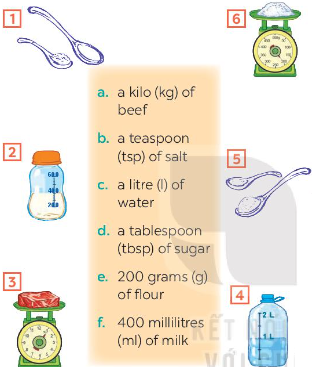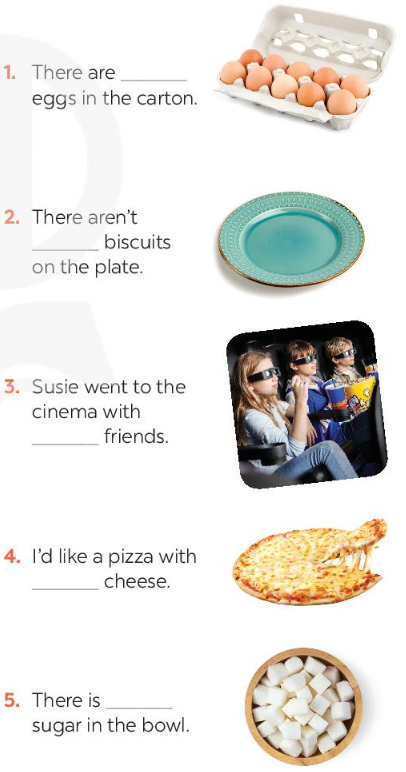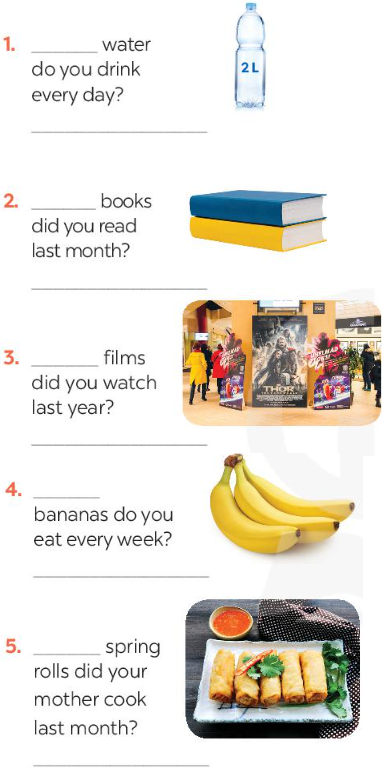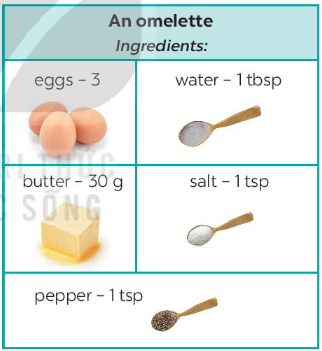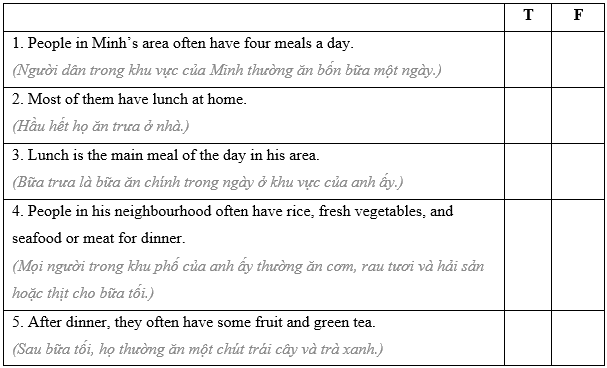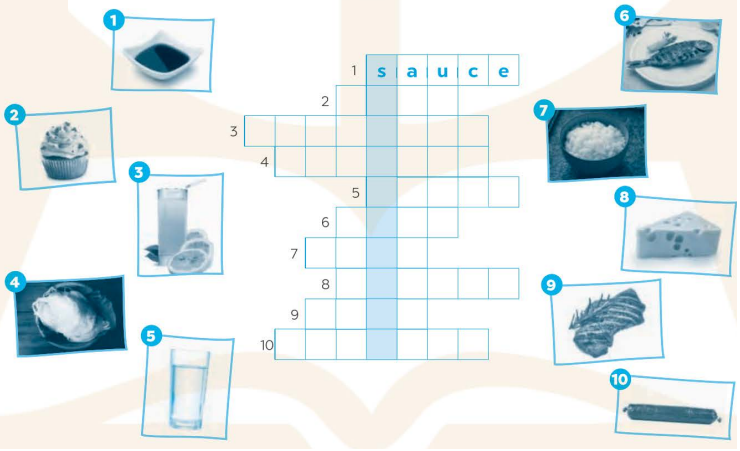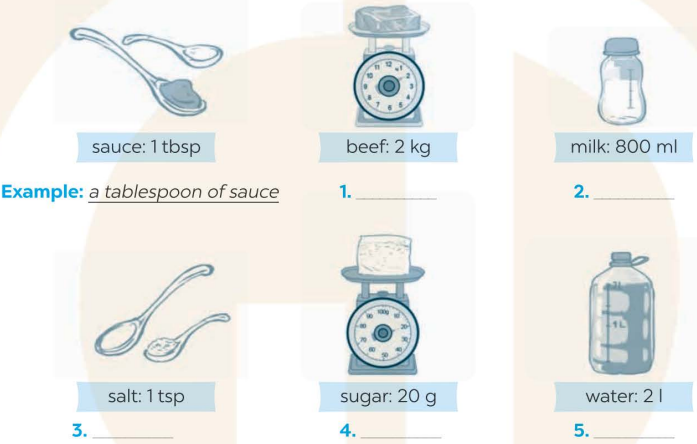Giải SGK, SBT Unit 5. Food and Drink Global Success
Giải SGK, SBT Unit 5 Global Success
4. Read the conversation again and tick (✓) T (True) or F (False).
(Đọc lại đoạn hội thoại và đánh dấu (✓) T (Đúng) hoặc F (Sai).)
|
|
T |
F |
|
1. Mark’s family is at a Vietnamese restaurant. |
|
|
|
2. Mark wants fried tofu and beef for dinner. |
|
|
|
3. They don’t order canh chua. |
|
|
|
4. Mark’s mum wants mineral water. |
|
|
|
5. His mum doesn’t allow her children to drink juice during dinner. |
|
|
2. Write the following words and phrases in the correct columns. Add any other dishes and ingredients you know.
(Viết các từ và cụm từ sau vào các cột đúng. Thêm bất kỳ món ăn và thành phần nào khác mà bạn biết.)
|
spring rolls omelette butter onions pancakes pepper |
|
Dishes |
Ingredients |
|
|
|
|
|
|
|
|
|
Pronunciation
/ɒ/ and /ɔ:/
4. Listen and repeat the words. Pay attention to the sounds /ɒ/ and /ɔ:/.
(Nghe và lặp lại các từ. Chú ý đến các âm /ɒ/ và /ɔ:/.)
|
fond short call water pork sauce lot not |
Now, in pairs write the words in the correct columns.
(Bây giờ hãy viết các từ vào cột đúng.)
|
/ɒ/ |
/ɔ:/ |
|
|
|
5. Listen and repeat, paying attention to the underlined words. Tick (✓) the sentences with the /ɒ/ sound.
(Nghe và lặp lại, chú ý những từ được gạch chân. Đánh dấu (✓) vào các câu có âm /ɒ/.)
|
1. I hate hot dogs. |
|
|
2. It's a very big pot. |
|
|
3. Put the forks here. |
|
|
4. This soup is very hot. |
|
|
5. I like pork cooked with vegetables. |
|
2. Work in pairs. Take turns to ask and answer about the prices of the food and drink on the menu.
(Làm việc theo cặp. Lần lượt hỏi và trả lời về giá cả đồ ăn thức uống trong thực đơn.)
|
LY’S RESTAURANT (NHÀ HÀNG LY) Breakfast menu (Thực đơn bữa sáng) |
|
|
Food (Thức ăn) |
|
|
bowl of beef noodle soup (bát phở bò) |
30,000 dong |
|
bowl of eel soup (bát canh lươn) |
35,000 dong |
|
toast (bánh mì nướng) |
20,000 dong |
|
Drink (Đồ uống) |
|
|
glass of milk (ly sữa/ cốc sữa) |
9,000 dong |
|
bottle of mineral water (chai nước khoáng) |
8,000 dong |
|
cup of green tea (tách trà xanh) |
5,000 dong |
Example:
A: How much is a glass of milk? (Một cốc sữa giá bao nhiêu?)
B: It's 9,000 dong. (9,000 đồng.)
4. Work in groups. Interview two of your friends about their favourite food and drink. Write their answers in the table below.
(Làm việc nhóm. Phỏng vấn hai người bạn của bạn về đồ ăn và thức uống yêu thích của họ. Viết câu trả lời của họ vào bảng dưới đây.)
|
Questions |
Student 1 |
Student 2 |
|
1. What’s your favourite food? |
|
|
|
2. What’s your favourite drink? |
|
|
|
3. What food and or drink do you want to try? |
|
|
|
4. What foreign food and drink do you like? |
|
|
|
5. What can you cook? |
|
|
Now report your results to the class.
(Bây giờ hãy trình bày kết quả cho lớp.)
Example: I interviewed A and B about their favourite food and drink. A's favourite food is …
(Ví dụ: Tôi đã phỏng vấn A và B về thức ăn và đồ uống yêu thích của họ. Thức ăn yêu thích của A là ...)
1. Read the blog about Vietnamese food. Choose the best answer (A, B or C) to each of the questions.
(Đọc blog về món ăn Việt Nam. Chọn câu trả lời đúng nhất (A, B hoặc C) cho mỗi câu hỏi.)
|
SOME INTERESTING FACTS ABOUT VIETNAMESE FOOD ➪Viet Nam is the second largest rice exporter in the world (only smaller than India). ➪People in Viet Nam eat the largest quantity of instant noodles in Asia. They even eat more instant noodles than people in Japan, where instant noodles came from. ➪Viet Nam has many kinds of noodles, such as pho, bun (vermicelli), mien (glass noodles), and banh da (rice noodles). ➪Nem ran (spring roll) is the most popular dish in Viet Nam. It isn't usually served as an everyday dish but mostly at a family gathering or an anniversary party. ➪Viet Nam has a large variety of che (sweet soup) with more than 100 kinds. ➪Viet Nam has nearly 200 kinds of cakes with various shapes and tastes. Some of them are not made from butter and flour, like banh chung or banh gai. |
1. India _____ in the world.
A. is the largest rice exporter.
B. has the smallest rice production.
C. is the second largest rice exporter.
2. The Japanese eat _____.
A. the largest quantity of instant noodles in Asia.
B. more instant noodles than the Vietnamese
C. a smaller quantity of instant noodle than the Vietnamese
3. In Viet Nam, spring roll is served _____.
A. as an everyday dish
B. only to elderly people
C. mostly on special occasions
4. The word “them” in the text refers to _____.
A. shapes
B. cakes
C. tastes
5. Which of the following is NOT true according to the text?
A. There are more than 100 kinds of che in Viet Nam/
B. Viet Nam has a large variety of noodles and che.
C. The Vietnamese always make their cakes from butter and flour.


